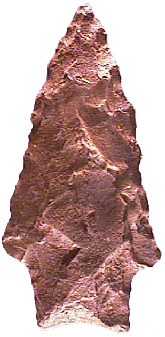

Point Type: APPALACHIAN
Also See: Abbey, Arredondo, Ashtabula , Bare
Island , Bascom, Broad River, Elora, Genesee, Gypsy Stemmed, Hamilton, Holmes, Johnson, Kirk Stemmed
, Levy, Maples, Oatlands, Otarre Stemmed, Savannah
River
, Seminole, Snook Kill, Stanly, Stanly Narrow Blade, Swatara, Thonotosassa
Location: Southeastern United States
Associated Dates:
4500 - 3500 B.P. - Late Archaic
Morphology: Stemmed
General Description: The Appalachian is a medium to large sized, rather crudely made stemmed knife form with a straight to contracting stem which has a concave or notched basal edge which resembles a slightly bifurcated base. Most examples are made from quartzite. The cross section is usually flattened. The shoulders are usually tapered and narrow. The blade edge is usually excurvate but may be straight and is most often found with an acute distal tip. The stem is broad and may be straight or expanded but most often is contracted with a concave basal edge which may be thinned. The hafting area of the stem is usually ground along the edges.
Although the point is most often made from quartzite, examples reveal well controlled percussion flaking with some retouch along the blade edges. The Appalachian is typically made from materials other than flint and most specimens are made from local quartzite, green or gray slates or shales and rhyolite with some of the better specimens made of coastal plain cherts. The workmanship, due to the poor materials used, appears to be crude. Distribution of the Appalachian is along the Southern Eastern Seaboard and the Southern Appalachian region from the Carolinas to Southern Georgia and west into Louisiana.
The size of the Appalachian point ranges from 60 mm to 120 mm in length. Typical examples are 44 mm wide and 10 mm thick with stems 18 mm long and 28 mm wide.
The Appalachian type was named by Madeline Kneberg in 1957 for the many examples that are found in the Southern Appalachian region where the type is widely distributed and most common. Many examples of the Appalachian were found by Kneberg at the Camp Creek Site. C. R. Harwood found the type in Site 6A on Hominy Creek in Buncombe County, North Carolina.
Note, Justice wrote that the Appalachian is essentially the same form as the Savannah River type however the Appalachian is usually larger than the Savannah River. In the Northeast, see the Genesee and Bare Island points for regional reference.
About the Point Above: The point pictured at the top of this page, is from Reston, Virginia and was found in a corn field as a surface find. It is a wide stemmed specimen, measuring 87 mm in length, 43 mm wide and 10 mm at its thickest point. The stem is 27 mm wide and is 17 mm long. The stem sides are also ground smooth and the stem is much thinner than the blade (6 mm thick at mid stem). The basal edge of the stem has a well formed, ground, 3 mm concavity. This blade is made from a very dark brown, highly patinated, fine grained rhyolite. The blade edges reveal some fine retouch and microscopic examination shows use wear on both blade edges. Catalog Number 149-40-I
References: Baker, Cambron & Hulse, Hranicky (1), Justice, Overstreet, Puckett (1), Waldorf
© Copyright 1997 - 2009 LITHICS-Net WWW.LITHICSNET.COM
Use Your Browser's BACK Button to Return to the LITHICS-Net Index.